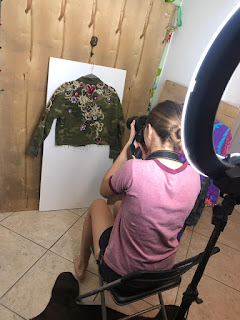Drum roll, please…
So...I FINISHED MY MAGAZINE!
It wasn’t an easy road though! Yesterday I had no school because my school had a super testing day. So I took this day to focus intensively on working on my magazine.
 |
| Almost at the finish line... |
Let’s start from the beginning:
Like I said last time, I decided on this cover after I added the pictures I shot with my sister onto my cover layout:
But, I found that the white coverlines did not stand out enough from the busy background, so they weren’t as readable as I liked.
So, like I’ve been doing throughout this whole project, I started researching. Let me tell you, I looked everywhere!! I first looked for fonts that were bolder in the default Canva fonts, but I found none that followed the genre conventions of beauty magazines (which were mostly serif, elegant fonts based on online covers and the 30 magazines I had spread out over my desk) and that stood out against the background. I then upgraded to the Premium level of Canva, which I did by using the 30-day free trial. This allowed me to upload free fonts from a website called dafont.com.
The website is really user-friendly, I've been using it since I was 10 years old for Powerpoint projects in school. It's important to note that when looking for a font to use for a project or business, that the font is labeled "free for personal use". Finding no fonts after searching up "magazine fonts" and "coverline fonts", I mostly searched for fonts under the "serif" section of the home page:
I then started playing around with bold fonts that I found on Dafont :
But again, this font didn't follow the conventions for other beauty magazines and didn't make the text stand out from the background. (I also played around with the colors a little to see what I liked).
I also searched the web for "how to make text stand out from a busy background" and found this helpful video. On minute 1:05 it explains how you can create a copy of the text, color it black, and place it behind your white text. This will then create a dark shadow behind your text that contrasts the original white text:
I was also inspired by this Vogue cover:
The coverlines have a slight black shadow around the white text to make them pop against the backdrop.
So, I tried this out with my coverlines:
And walla! I think it looks a lot better. I discussed this with my team members, and they told me they loved the idea and added the element to their cover.
My group also agreed to use the font "Vogue" for the masthead, which we thought best represented the conventions of beauty magazine mastheads (professional and with serifs). So we all downloaded the font and uploaded it onto Canva to use.
As for post-production editing on the cover image, I just added a little contrast, saturation, and brightness. (I'm not sure why her face looks orange in this picture, but it's not orange in Canva!)
Tini also found a website that makes custom barcodes, so Catalina made a barcode for all of us and I added it to my cover with the same dimensions as my partners.
Next blog post I will talk about how I created my table of contents, ad, and finally the double page spread.
Will be writing soon,
Malena
A Guide on How to Design a Magazine Cover that Will Stand Out. (2016, October 08). Retrieved from https://naldzgraphics.net/how-to-design-magazine-cover/


















































